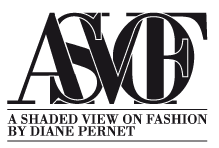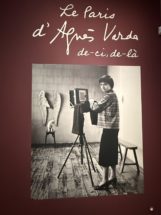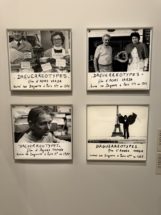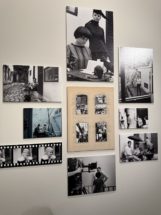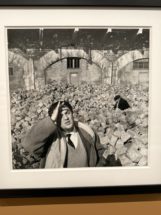Dear Shaded Viewers,
Agnès Varda was born in Ixelles, Belgium, in 1928, into a bourgeois family that valued comfort and stability. Her upbringing was marked by privilege, and her parents expected her to follow a conventional path. However, Varda defied these expectations when she moved to Paris and chose an unconventional lifestyle that reflected her independent spirit and artistic vision. Despite her parents purchasing an apartment for her, she opted instead for a dilapidated garage-like space at 5, rue Daguerre in the 14th arrondissement—a place with no heating or plumbing. This decision baffled her family, who struggled to understand how she could live in such conditions. Yet for Varda, this unassuming space became a sanctuary of creativity and experimentation, where she lived and worked until the end of her life. Her choice to embrace simplicity over comfort exemplified her commitment to authenticity and her rejection of bourgeois conventions, qualities that would define both her art and her life.
Agnès Varda’s romantic relationship with Valentine Schlegel, a sculptor and ceramicist, was an important chapter in her life that shaped her early artistic journey. Valentine, who was openly lesbian, shared Varda’s home and studio on Rue Daguerre for six years during the 1950s—a period when Varda was beginning to explore photography and cinema. Their bond was both personal and professional, with Valentine encouraging Varda to pursue her creative ambitions. Despite the significance of this relationship, Varda regarded her sexuality as a private matter and rarely discussed it publicly. Her daughter, Rosalie, later confirmed the relationship after Varda’s death, shedding light on this formative connection. While Varda eventually married Jacques Demy, her time with Valentine remains a testament to her unconventional life and the diverse influences that shaped her artistry.
Agnès Varda’s work was as much a love letter to Paris as it was a testament to her unyielding creativity. Now, the exhibition Le Paris d’Agnès Varda, de-ci, de-là at the Musée Carnavalet offers a fresh perspective on her oeuvre, inviting audiences to explore her artistic legacy through the lens of her lesser-known photography and her intimate connection to the city she called home.
The exhibition Le Paris d’Agnès Varda does more than honor the filmmaker’s cinematic achievements—it shines a light on her lesser-known photographic work and the profound role of the courtyard-atelier at 5, rue Daguerre in Paris’s 14th arrondissement. This unassuming space, where Varda lived and created from 1951 to 2019, was not merely a backdrop but a vibrant hub of artistic experimentation. Initially a photography studio and development lab, it hosted her first solo exhibition in 1954 and later evolved into a communal haven shared with Jacques Demy in the 1960s. The courtyard became a meeting point for figures from cinema and theater, fostering collaborations that enriched her work.
More than a physical location, the courtyard symbolized Varda’s ability to blend documentary realism with poetic fiction, transforming everyday spaces into sites of creativity. The exhibition immerses visitors in this evolution, using archival photographs, personal artifacts, and film excerpts to illustrate how Rue Daguerre became central to her artistic ethos—a recurring motif that reflected her seamless merging of life and art.
The exhibition takes visitors on a journey through time and space, beginning with Varda’s early days as a photographer. It revisits her first solo exhibition in 1954 and traces her creative interactions with figures such as Jacques Demy, her husband and fellow filmmaker. Through archival photographs, objects, and documents, we see how Rue Daguerre became both muse and collaborator—a place where life and art intertwined seamlessly.
The exhibition also highlights Varda’s singular vision of Paris itself—a city captured through her playful, offbeat lens. Her photographs reveal an eye attuned to humor, strangeness, and humanity in equal measure. A thematic chronology showcases how Paris shaped her films, from Cléo de 5 à 7 (1962), where the city mirrors the emotional journey of its protagonist, to later works that continue this intimate dialogue between urban space and personal narrative.
What makes this exhibition truly remarkable is its depth of research. Drawing from over two years of investigation into Varda’s photographic archives and Ciné-Tamaris collections, it brings together 130 prints—many previously unseen—and film excerpts that span decades. Alongside these are personal artifacts: publications, film posters, objects belonging to Varda herself, and even a sculpture of her beloved cat Nini. These elements create a multi-dimensional portrait of an artist who defied convention at every turn.
The curatorial team deserves recognition for their thoughtful approach. Led by Valérie Guillaume (director of Musée Carnavalet) and Anne de Mondenard (heritage curator specializing in photography), alongside contributions from leading experts like Antoine de Baecque and Dominique Païni, they have crafted an experience that bridges photography and cinema while honoring Varda’s spirit of innovation.
Ultimately, Le Paris d’Agnès Varda reminds us why Varda remains such a vital figure in contemporary art history: she refused to separate documentary from fiction or life from art. Her Paris was not just a setting but an active participant in her creative process—a city seen through eyes that never ceased to marvel at its beauty or complexity.
This exhibition is more than a retrospective; it is an invitation to rediscover Agnès Varda’s Paris—not as she saw it alone but as she helped us see it anew.
Later,
Diane
Musée Carnavalet – Histoire de Paris
23 rue Madame de Sévigné
75003 Paris
